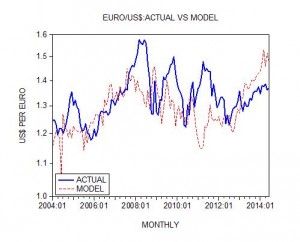According to the Nobel Laureate in Economics, Milton Friedman, the root of the business cycle is the fluctuations in the growth rate of money supply.
Friedman held that what is required for the elimination of these cycles is for central bank policy makers to aim at a fixed rate of growth of money supply:
My choice at the moment would be a legislated rule instructing the monetary authority to achieve a specified rate of growth in the stock of money. For this purpose, I would define the stock of money as including currency outside commercial banks plus all deposits of commercial banks. I would specify that the Reserve System should see to it that the total stock of money so defined rises month by month, and indeed, so far as possible, day by day, at an annual rate of X per cent, where X is some number between 3 and 5. The precise definition of money adopted and the precise rate of growth chosen make far less difference than the definite choice of a particular definition and a particular rate of growth.[1]
Now if economic cycles are caused by fluctuations in money supply growth then it makes a lot of sense to eliminate such fluctuations. In this sense, the constant money growth rate rule seems to be the right remedy to eliminate such cycles.
We suggest that what sets in motion these cycles is not fluctuations in the growth rate of money supply as such but the fluctuations in the growth rate of money supply generated out of “thin air”. By money “out of thin air” we mean money that is created by the central bank and amplified by fractional reserve lending by commercial banks.
An increase in the money supply out of “thin air” provides a platform for non-productive activities, which consume and add nothing to the pool or real wealth. Money out of “thin air” diverts real wealth from wealth generators to non-wealth generating activities, thus weakening the wealth-generating process.
The diversion occurs once various individuals that are the early receivers of this newly created money are exchanging new money for goods and services by contributing nothing to the pool of goods and services. Wealth generators that have not received this newly printed money discover that they can now secure fewer goods than before. (The increase in the prices of goods and services manifests this).
Whilst the increase in the growth rate of such money stimulates non-productive activities, a fall in its growth rate undermines those activities. Their ability to divert real wealth from wealth generators is thereby curtailed.
Note that since non-productive or bubble activities do not generate any real wealth they cannot secure the goods they require without the support from newly created money.
Once the proportion of non-productive activities from overall activities starts to increase, this tends to put pressure on the profitability of companies. This in turn raises the likelihood of an increase in banks’ bad assets. Consequently, banks expansion of credit through the fractional reserve lending (i.e the expansion of lending out of “thin air”) is likely to slow down, and this in turn is likely to weaken the growth rate of money supply.
In a fractional reserve lending world once the borrowed money is repaid to the bank and the bank does not renew the loan, the money disappears. In the case of non-fractional reserve lending, once the money repaid by the borrower, it is transferred to the original lender, and so no change in money supply is going to occur. (In the case of fractional reserve lending, once the money repaid to the bank it disappears from the economy as there is no original lender here to whom money is going to be returned).
A fall in the growth rate of money out of “thin air” is thereby going to undermine, various non-productive activities that arose from and were supported by the fractional reserve bank lending. This sets in motion an economic downturn.
We have seen that the expansion in money supply supports the emergence of non-productive activities. So if the fixed money rule were to be enforced, over time it would lead to the expansion of non-productive activities. (A fixed money supply rule is still about the expansion of money out of “thin air” though at a fixed rate). This, as we have seen, is going to weaken the wealth generators and thus undermine the real economy.
We can conclude that Friedman’s monetary rule is simply another way of tampering with the economy and, hence, it cannot lead to economic stability.
Would the introduction of a gold standard eliminate boom-bust cycles? According to Friedman what causes boom-bust cycles is fluctuations in the growth rate of money supply. Hence, from this perspective, also on the gold standard there are going to be fluctuations in the growth rate of money supply. Hence, according to Friedman, the introduction of a gold standard is not going to eliminate business cycles.
It is true that the variability in the growth rate in the production of gold will create fluctuations in the growth rate of money supply. As opposed to the expansion in the money supply on a paper standard, however, the increase in the money supply on a gold standard will not result in an exchange of nothing for something. It will not result in the diversion of wealth from wealth producers towards non-wealth generating activities.
Being a commodity, apart from providing the services of the medium of exchange gold is also demanded for various industrial uses including jewellery. From this perspective it is part of the pool of real wealth. So when gold exchanged for goods and services – something is exchanged for something else.
Note that the increase in the supply of gold is not an act of embezzlement or fraud. The increase in the supply of gold doesn’t produce an exchange of nothing for something.
Contrast this with the printing of gold receipts i.e. receipts that are not backed 100% by gold. This is an act of fraud, which is what inflation is all about. It sets a platform for consumption without making a contribution to the pool of real wealth. Empty certificates set in motion an exchange of nothing for something, which in turn leads to recurrent cycles.
Again, in the case of the increase in the supply of gold no fraud is committed. The supplier of gold – the gold mine – has increased the production of a useful commodity. So in this sense we don’t have here an exchange of nothing for something. Consequently, we also don’t have an emergence of bubble activities. A wealth producer (on account of the fact that he has produced something useful) can exchange it for other goods. He doesn’t require money out of “thin air” to divert real wealth to him.
On the gold standard an increase in the growth rate of money, which is gold, will not set in motion the emergence of bubble or false activities i.e. an economic boom. Hence a fall in the growth rate of money supply is not going to create an economic bust – no bubble or false activities were created that are going to be destroyed by a slower money supply growth rate.
We have seen that the disappearance of money out of “thin air” is the major cause of economic downturns. (The injection of money out of “thin air” generates bubble activities whilst the disappearance of money out of “thin air” destroys these bubble activities).
On the gold standard, this cannot occur. On a pure gold standard, without the central bank, money is gold. Consequently on the gold standard money cannot disappear since gold cannot disappear unless it is physically destroyed, which is an unlikely proposition. We can thus conclude that the gold standard, if not abused, is not conducive of boom-bust cycles.
Conclusions
The famous economist Milton Friedman observed that fluctuations in the growth rate of money supply could be an important factor behind boom-bust cycles. Hence, he suggested that central banks should aim at stabilizing the growth rate of money supply at around some percentage and keep it at this number for an indefinite time. By maintaining the growth rate of money supply at a fixed percentage, Friedman held that the economy would follow a path of stable economic growth without boom-bust cycles. Friedman’s money rule, however, is still about printing money and, in this sense, it is going to generate the same effect as any money printing does i.e. boom-bust cycles. We have shown that what matters for economic cycles is not fluctuations in the growth rate of money supply as such but fluctuations in the growth rate of money out of “thin air”. We have shown that only a pure gold (or some commodity) standard is immune from such cycles.
[1] Milton Friedman – Dollars And Deficits – Prentice Hall Inc 1968 p 193.





Here is my simplified model for an economy:
Given a two family economy in which each family hires the other and each family spends all of its income on the output produced by the other family, both families will be fully employed.
Given then that one person in one family starts to save some money, the other family will no longer be fully employed.
Given that one member spends money on imports and there are no offsetting exports to bring spending back in, some members of the other family will be less than fully employed.
Given that some members of one family no longer want to borrow money and spend it on the output of the other family, some members of the other fully will be less than fully employed.
When all of these spending cycles reverse and re-enforce each other there will be too much spending and prices will rise.
If all of these spending cycles trend the other way there can be a downwards spiral into recession.
CONCLUSION
There is more to economic cycles than just the stock of money in circulation even if it is defined as MA.